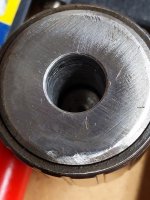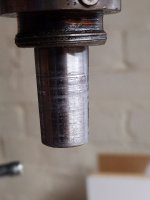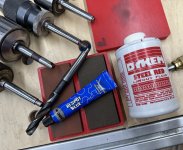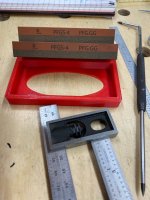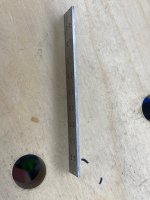Preface: I'm not really a drill press power user, but have an old craftsman benchtop press (like this, but not as nice) that I mostly use for drilling perpendicular holes. I've had it for about 5 or 6 years now and generally it's fine. I don't trust it in terms of runout but usually I'm more worried about angle than precision.
I'm working on a lathe stand with some big mortises and wanted to use the drill press to rough out the bulk of it. I'm using a nice Wood Owl 7/8 brad point auger bit (each mortise is about 1.75" wide and 3" long). All is going well until I start drilling out the holes between the ends and the bit wants to shift towards the hole. There's a bit of vibration, but I've got the workpiece trapped between two fences.
Eventually, whole chuck came right off with the bit in it. This happened once before and I just knocked the chuck back onto the quill assembly and moved on. However, today, no amount of knocking seemed to make it stick. At best, I'd get it running for a couple of holes but as soon as any sideways pressure happened it popped back off.
I tried cleaning off the taper and socket with acetone, followed by 99% alcohol, just to be sure nothing was interfering with the fit. I did notice that the surface on the quill looks pretty rough, as does the inside of the chuck's socket.
[attachimg=1]
[attachimg=2]
I'm guessing that the surface of these two things is probably interfering with making a good strong wedged fit, and that's part of why the chuck keeps falling off. Am I headed in the right direction? Or should I be looking at something else? Would this issue have anything to do with how much runout my drill press seems to have?
I'm working on a lathe stand with some big mortises and wanted to use the drill press to rough out the bulk of it. I'm using a nice Wood Owl 7/8 brad point auger bit (each mortise is about 1.75" wide and 3" long). All is going well until I start drilling out the holes between the ends and the bit wants to shift towards the hole. There's a bit of vibration, but I've got the workpiece trapped between two fences.
Eventually, whole chuck came right off with the bit in it. This happened once before and I just knocked the chuck back onto the quill assembly and moved on. However, today, no amount of knocking seemed to make it stick. At best, I'd get it running for a couple of holes but as soon as any sideways pressure happened it popped back off.
I tried cleaning off the taper and socket with acetone, followed by 99% alcohol, just to be sure nothing was interfering with the fit. I did notice that the surface on the quill looks pretty rough, as does the inside of the chuck's socket.
[attachimg=1]
[attachimg=2]
I'm guessing that the surface of these two things is probably interfering with making a good strong wedged fit, and that's part of why the chuck keeps falling off. Am I headed in the right direction? Or should I be looking at something else? Would this issue have anything to do with how much runout my drill press seems to have?

